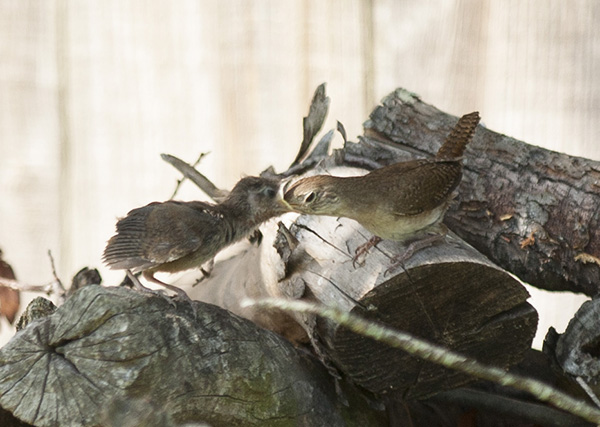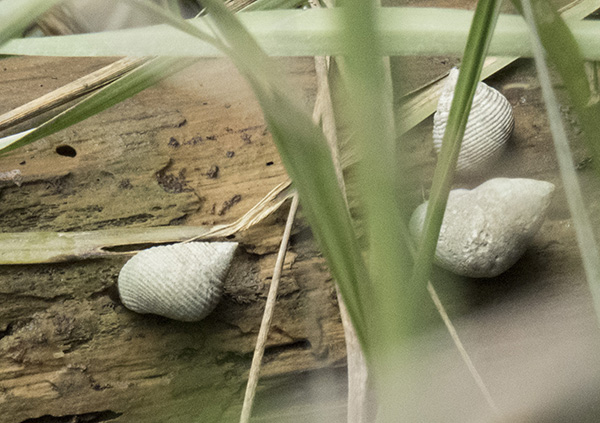Each spring, our semi-wild population of suburb mallards leave their lakes, ponds, and canals in search of private nesting habitats. This local migration often brings pairs of mallards to the yard, though none have stayed to nest. Until this year.

Less than a week after I posted about the dragonfly pond, a pair of mallards arrived and began redecorating the pond. They shoved rocks from the border, collapsed minnow caves, uprooted plants, stirred sediment into columns of mud, and added enough nutrient (in the form of duck poop) to start a massive algae bloom.



The dragonfly pond soon looked and smelled like a cattle pond.
The ducks ate everything they could catch in the water. Minnows and dragonfly larvae, damselfly larvae and snails. Anything that swam or wriggled.2
We shooed and herded the pond-wrecking mallards, who returned day after day for further wreckage. I complained to family and friends about the mallards’ destructive invasion, but I also hoped for a nest. Truth be told, I always hope for nests. Plus, I have nostalgic affection for ducks.




Hoping to lure the mallards away from the pond for at least a few hours each day, I purchased a blue plastic wading pool (definitely a theme in my lifelong efforts to keep waterfowl happy) and an extra bag of wild bird feed. Pool and feed in hand, I set up a duck station near the fence in our Virginia back yard, including steps for easy entry into the pool. Then I herded the mallards out of the pond and toward the pool.

Not surprisingly, the mallards saw peril in the duck station and refused to try the wading pool. At that point, the pair were still semi-wild, after all. They retreated into the pollinator beds and rummaged through duff when I was in the yard, then circled back to the pond when I went inside.
And the pond grew more and more fetid. (I had almost forgotten the smell of our chicken house in Tennessee, and sometimes the yard when our flocks grew too populous, but now I’ve been reminded.)

When the female mallard built her nest in the irises and began laying, we stopped all efforts to shoo or herd or otherwise interfere. Almost immediately, the mallards took to the wading pool for luxurious sessions of bathing and splashing.



Resigned to a lengthy mallard residency, we invested in a pump and filter for the pond. For the next month, I cleaned the pond filter daily, dumped and refilled the wading pool every other day, put out feed each morning and evening, and lingered in the kitchen window for hours on end, watching. The mallards hunted in the pond (and further rearranged the rocks), bathed and basked in the wading pool, ate their feed and grazed through the yard, and generally unwilded until they were as comfortable in the yard as our domestic flocks had been in the yard of my childhood home.
And while the mallards unwilded, the nest grew.



On April 1, with nine eggs in the nest, the female mallard settled to incubating. Giving up all pretense of productivity, I sat in the kitchen window, day after day. While she sat on her nest. Day after day.



And then, on April 28, the hatching commenced. All afternoon the mallard fidgeted and turned and tended, eating some of the discarded shells and membranes, tucking the rest under the nest’s foundation of dried grasses. By nightfall the nest was filled with ducklings instead of eggs.



I set my alarm for sunrise the next morning, certain that the female mallard would lead her brood away as soon as the hatchlings were mobile enough. I didn’t want to miss a moment of their brief stay in the yard.










And, of course, they didn’t stay.
I followed the mallards as their mother led them out of the yard and down our street and through a playground and up the next street over to a house on a canal without a fenced back yard. The homeowner was working in his yard when our odd parade arrived, and he nodded and shrugged when I waved from the sidewalk across the street. He told me that mallard mothers lead their brood through his yard, the only unfenced yard along the canal, all spring long. They head for the canal despite its dangerous populations of snapping turtles, snakes, and bullfrogs large enough to eat a baby duck. We agreed that yards are safer but mallards need canals.
Then I trudged home alone, wishing for a world both more and less wild.
I was shocked when the mallard led her brood back, that evening. My husband saw them coming up the sidewalk and called for me. The female mallard had guided her dozen day-old ducklings out into the canal and back again, safe and tired. We opened the gate and welcomed them home, pond wreckage forever forgiven as the sleepy family spilled back into their nest.
The next morning they left for good, of course. The yard, for all of its unwild safety, is not meant for mallards. Nor are mallards meant for the yard.
They haven’t returned, and they won’t. At least, not as the same little family that left. But every mallard I see, for all my years to come, will be one of them.
The Unwild Mallards The unwild mallards were stubborn and messy Unwily in their need And the pond was water enough for nesting An unwild nest In unwild irises A quick meal and a bath Then back to the nest Days growing longer and hotter In the unwild yard With unwild waters And then The unwild dozen That afternoon, they left Then returned for one last night Before they left for good Heading toward the good wild waters Where unwild mallards might learn To be wild
Footnotes
1 We added the board after removing a commercial floating planter/island. We removed the island because it was ruined, then added the board because we felt sorry for the minnows that had enjoyed hanging out under the island. (Click here to go back.)
2 The ducks were not so efficient as to depopulate the minnows and invertebrates. I’m not certain how anything survived, between the feasting and the fouling, but some survived and carried on. Currently, the pond is teeming with baby minnows and every surface is clumped with snail eggs. (Click here to go back.)
3 This is another of my oldest sister’s “Rae with pets” series of photos, which span years and will likely continue to appear on this blog. In the background, two chickens and our shepherd make guest appearances. (Click here to go back.)
4 After our father left, the job of stacking wood fell to me. Mother purchased cut wood from a neighbor, who unloaded it in a heap. I would sort the wood by size and age, stacking it all in our pole shed. The freshest cuts went at the bottom of the pile (to age/cure) and the aged/cured wood at the top. The largest logs started at the left and the smallest kindling at the right. I even sorted the wood according to Mother’s lore: she believed that the hardest woods (usually hickory and oak) burned long and hot, the softer woods (often maple and hackberry, but sometimes others that I didn’t recognize) burned fast and cool, and the evergreens (pines and the occasional cedar) burned oily and deposited more creosote in the chimney. When bad weather was forecast, I brought days or weeks worth of wood to the porch, where it stayed drier than the shed. But Mother didn’t like keeping wood stacked on the porch because warm air escaping through the door woke the woodpile’s insects, who followed the warm air indoors. (I never had cause to doubt Mother’s wood fire lore and would likely stack wood by size and hardness, away from the porch, if we burned wood for heat today.) (Click here to go back.)
5 The wading pool was the closest thing they had to a pond. A second blue plastic wading pool, visible in the background, was in the dog pen and helped our dogs stay cool. The second pool also kept the dogs from digging under the fence because they wanted to play in water. (Click here to go back.)
I regret that I do not have a list of links, for this post, to articles and essays that are more important and more interesting than the small unfoldings in our small yard. I have been tired, of late, and taking a break from the larger world. I will resume reading and exploring and learning once I have regathered my energy, both emotional and physical. In the meantime, please post links of your own, to articles and essays that have helped you better understand the world. (Please also note that I screen comments.)






























































